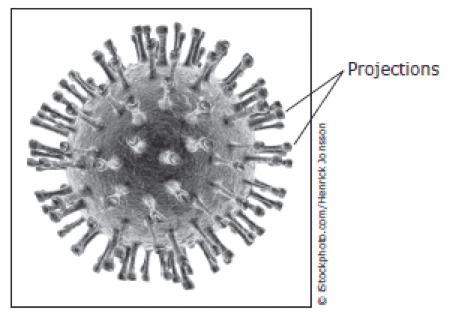Feel free to use or edit a copy
includes Teacher and Student dashboards
Measures 1 skill from
Measures 1 skill from
Track each student's skills and progress in your Mastery dashboards
With a free account, teachers can
- edit the questions
- save a copy for later
- start a class game
- automatically assign follow-up activities based on students’ scores
- assign as homework
- share a link with colleagues
- print as a bubble sheet
10 questions
Show answers
- Q1A photograph of a virus is shown below. The projections on the surface of this virus allow the virus to-attach to a host cellcontrol a host cell’s DNAsignal other viruses to infect a host cellmove inside a host cell30sBIOL.4c
- Q2Cold sores are caused by the herpes simplex virus type 1. A company that wants to develop antiviral drugs would ask a research immunologist to study-meiosis in the virusthe mechanism used by the virus to infect cellshow closely related the virus is to cold virusesthe metabolism of the virus30sBIOL.4c
- Q3A person infected with the human immunodeficiency virus (HIV) may not have any symptoms for a period of time. During this period the virus affects the body by doing which of the following?The virus uses nutrients meant for immune cells to fuel its own cellular respiration.The virus changes the identity of the nucleotides of immune cells to prevent the immune system from functioning normally.The virus damages immune cells while using their machinery to produce copies of itself.The virus produces toxins that weaken immune cells and prevent them from reproducing.30sBIOL.4c
- Q4Severe acute respiratory syndrome (SARS) is an illness caused by a corona virus. Symptoms including a high fever, headaches, and body aches typically occur two to seven days after infection by the virus. SARS is more serious in elderly patients. This information suggests that the reproductive cycle of the SARS virus is-lytic, because of the quick onset of symptoms after infectionlytic, because the virus causes respiratory illnesslysogenic, because the virus is a coronaviruslysogenic, because the virus primarily affects older people30sBIOL.4c
- Q5Models of the human immunodeficiency virus. What is the difference in the function of the glycoprotein structures of an HIV virion and the cilia of an animal cell?The glycoprotein structures are used to provide physical support for the viral envelope, and the cilia strengthen the cell membrane.The glycoprotein structures are used for defense, and the cilia are used for locomotion.The glycoprotein structures are used to obtain nutrition, and the cilia are used to secrete proteins.The glycoprotein structures are used for attachment, and the cilia are used to move fluids surrounding the cell.30sBIOL.4c
- Q6H1N1 flu is a highly contagious viral infection caused by the influenza A (H1N1) virus. The symptoms of H1N1 flu are listed in the box. An antiviral agent administered within 48 hours of the appearance of symptoms can reduce the severity of the illness. Why is it important to administer an antiviral agent to an infected person within 48 hours of the appearance of symptoms?The H1N1 virus does not mutate.The H1N1 virus replicates quicklyThe H1N1 virus is transmitted through a vector host, such as a mosquito.The H1N1 virus is dormant in cells.30sBIOL.4c
- Q7The picture shows a 3-D model of a virus called a bacteriophage. Bacteriophages can infect bacteria such as E. coli. In what way are the bacteriophage and E. coli alike?They have identical genomes.They lack membrane-bound organelles.They reproduce by mitosis.They contain antibodies.30sBIOL.4c
- Q8A student produces a labeled drawing of a virus for a presentation. the student states that the capsid has a function similar to the nuclear membrane found in animals cells. Which of these describes the similar functions of capsids and nuclear membranes?both transport proteins throughout the structuresBoth protect genetic information for the structuresBoth code for the proteins needed for reproduction of the structures.Both provide energy for activities in the structures30sBIOL.4c
- Q9In 1898 Friedrich Loeffier and Paul Frosch found evidence that the cause of the highly contagious hook and mouth disease in livestock was a microscopic infectious particle. It was discovered that this particle requires a host cell to reproduce. Which pathogen is most likely responsible for causing hook and mouth disease in livestock?A protist, because it is microscopicA fungus, because it infects livestockA bacterium, because it is contagiousA virus, because it requires a host cell to reproduce30sBIOL.4c
- Q10In the 1880s, Louis Pasteur developed a method of weakening viruses. The weakened viruses could be injected into healthy individuals. How is this method effective in fighting viral diseases?Weakened viruses are unable to enter the host organism.the weakened viruses attach to unaffected viruses in the host and interrupt the viral reproductive cycle.The immune system develops antibodies in response to the weakened viruses.The rate of genetic mutation in the host is decreased due to the introduction of weakened viruses.30sBIOL.4c

